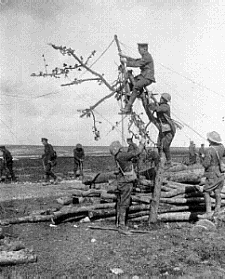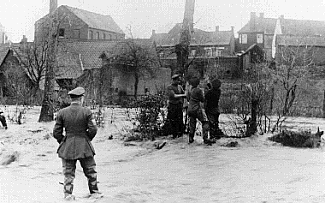![[Red Line]](rd2line.gif)
![[Red Line]](rd2line.gif)
![[Canadian Engineer and his invention for twisting telephone cable. September 1917.]](3818.gif)
The Allies resorted to various methods of getting the messages through the lines during the most
difficult times. These methods helped maintain contact between the front line and headquarters.
Constant contact was essential to success.
Balloon and aeroplane surveillance, aerial photography, trench raids, prisoner questioning, range
sounding, telephone cables (either buried or on poles), flash spotting, carrier pigeons, dogs,
runners, motorcycles, Morse code, wireless (radio), light signaling, flares, and flags were all helpful in gathering and relaying information for planning.
 Telephone communication was often used to relay messages. At times, it was impossible
to maintain the telephone lines because of the heavy artillery shelling. In an effort to
prevent the telephone lines from being destroyed, the lines were buried six to eight feet
below the ground.
Telephone communication was often used to relay messages. At times, it was impossible
to maintain the telephone lines because of the heavy artillery shelling. In an effort to
prevent the telephone lines from being destroyed, the lines were buried six to eight feet
below the ground.
To ensure constant communication when telephone lines were destroyed, signal lights were used. These signal lights were a necessary tool but had to be carefully located. This was to prevent detection of the beams of light by the enemy. Even with this new technology, traditional ways of communicating were not forgotten. Trained dogs, carrier pigeons and cyclists were capable of getting the job done when other methods were not practical or possible.
![[Canadian Engineers- Engineers repairing bridge blown up by Germans, Battle of Amiens, August 1918.]](2902b.gif) Cyclists were often used to gather information about bridges, rivers and other critical
physical features of the land. All of this information would improve the preparation of a
planned move.
Cyclists were often used to gather information about bridges, rivers and other critical
physical features of the land. All of this information would improve the preparation of a
planned move.
Knowing information about the layout of the land helped engineers remove any barriers for troops while they moved forward against the enemy. Often bridges were destroyed or damaged during battle and would need repair. Cyclists would inspect bridges to determine if any repairs were needed. Log roads over the mud, dugouts, trenches and railroads were also constructed. Using information gathered by cyclists, engineers would decide the best location for a bridge or road. This was done using the natural layout of the land. Railroads, powered by horses, provided easy passage of supplies to the battle fronts.
![[Communications Trench]](comm1.gif) On the Western front, both sides resorted to trench warfare. Trench warfare was not only beneficial to securing one's position on the front, but it also served as a means of communication. Moving supplies and troops to and from the front line was done safely using the
trenches. In the forward areas, observation and listening posts were set up to monitor enemy
activities. Canadians began carrying out surprise trench raids at night to gather information. Though
these raids were dangerous, they kept the Germans on edge.Within the tunnels, there were also
communication cables connecting the trenches with one another and headquarters.
On the Western front, both sides resorted to trench warfare. Trench warfare was not only beneficial to securing one's position on the front, but it also served as a means of communication. Moving supplies and troops to and from the front line was done safely using the
trenches. In the forward areas, observation and listening posts were set up to monitor enemy
activities. Canadians began carrying out surprise trench raids at night to gather information. Though
these raids were dangerous, they kept the Germans on edge.Within the tunnels, there were also
communication cables connecting the trenches with one another and headquarters.
One Canadian improvement that provided easier passage through the mud was bath mats. These
bath mats or log roads over the mud, originally used in northern Ontario, also proved to be useful
on the war front. Tanks, mules, soldiers, and supplies moved back and forth from the front lines on
top of the mats with greater ease. They were also very useful in the mud- and water-filled trenches,providing soldiers with some relief.
The Canadian Corps realized that planning was a vital part of success. They also realized that
accurate, up-to-date information was needed for a plan to be successful. At Vimy Ridge, in
France, the Canadians were successful in defeating the Germans by devising an elaborate plan of
attack. This plan relied heavily on rapid communication of gathered information. During the Battle
of Vimy Ridge, maps were drawn up with this information, indicating trench and mine locations as
they would be found on the German side. A replica of the battlefield and the enemy line was then
effectively recreated with the information gathered from trench raids, balloon surveillance and other
means. On this replica battlefield, there were frequent rehearsals to prepare the soldiers for what
lay ahead. The Canadians were leaving nothing to chance.
All levels of the Canadian Corps were aware of the scope of their duties and the Corps' objectives.
This approach encouraged initiative in the soldiers. They were then able to be independent and to
think quickly during an attack.
The Royal Canadian Corps of Signals also supported the Canadian Army by using their new
technology. They were able to pass on valuable information about German activities gathered by
aerial surveillance. From both the balloons and airplanes, the Allies were clearly able to pinpoint
the position of the enemy. This information would then be passed on to the artillery. Using this, the
artillery's accuracy dramatically cut down on the German counter-attack.  On the ground, new techniques were also used by the Canadians Signalers to locate German guns. They were sound ranging and flash spotting. Both of these were very complex yet useful activities. They
were capable of pinpointing their targets within metres of their actual location. This accuracy
helped the Canadians to destroy the German guns and limit enemy counter-attack.
On the ground, new techniques were also used by the Canadians Signalers to locate German guns. They were sound ranging and flash spotting. Both of these were very complex yet useful activities. They
were capable of pinpointing their targets within metres of their actual location. This accuracy
helped the Canadians to destroy the German guns and limit enemy counter-attack.
Along the battlefront, Canadians built listening posts to watch enemy gun fire. These posts had
telephones and observation equipment. Any information gathered would be sent back to
headquarters where there was a system of lights to pass on the information.
Sound ranging relied on the oscillograph which recorded sound waves from gunfire and exploding
shells. In No Man's Land, there were listening posts which had links to headquarters. When an
enemy gun fired, the sound would be recorded at headquarters using cues from the listening posts.
Also, at other locations behind the forward lines, there were microphones used to record the sound
waves of exploding shells that fell on the trenches or behind the Canadian lines.
Prisoners were also a good source of information. They were questioned about the effectiveness of
Canadian attacks. This information was then used to improve weak areas.
With this elaborate system of communication, co-ordination was improved, creating better
interaction between different units and the Canadians were better able to synchronize their efforts.
![[Up arrow]](ottmem3.gif) | ![[Main arrow]](c3.gif) | ![[Back arrow]](c2.gif) |
| [VAC] | [Main] | [Back] |